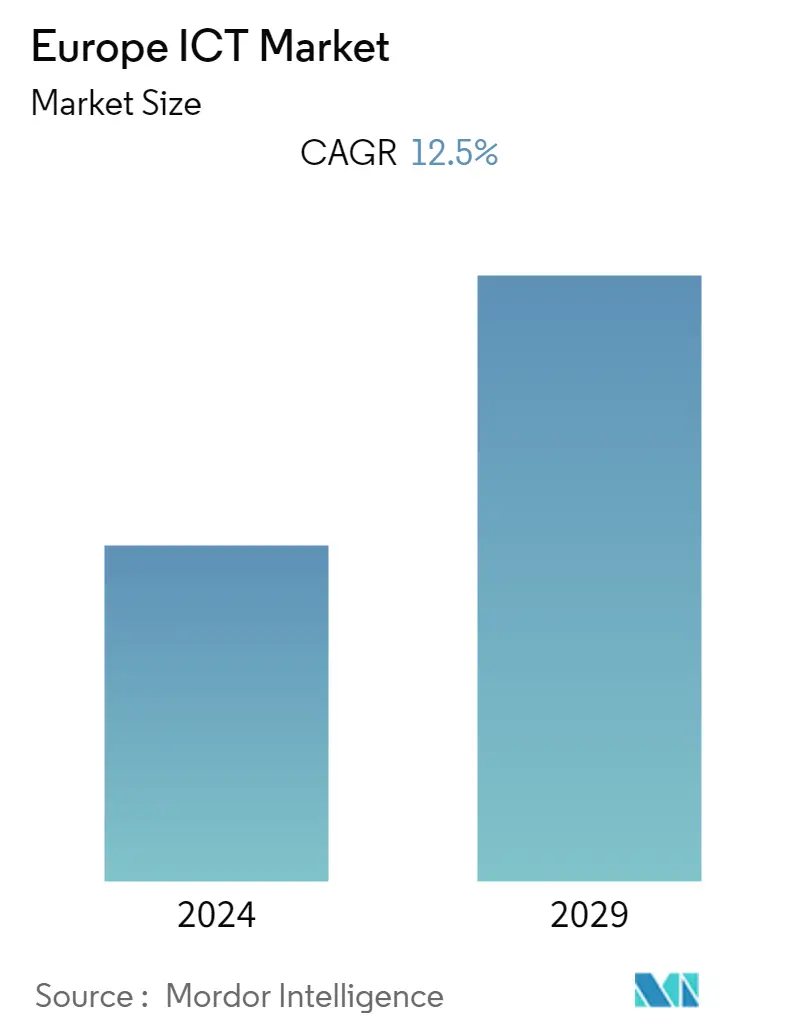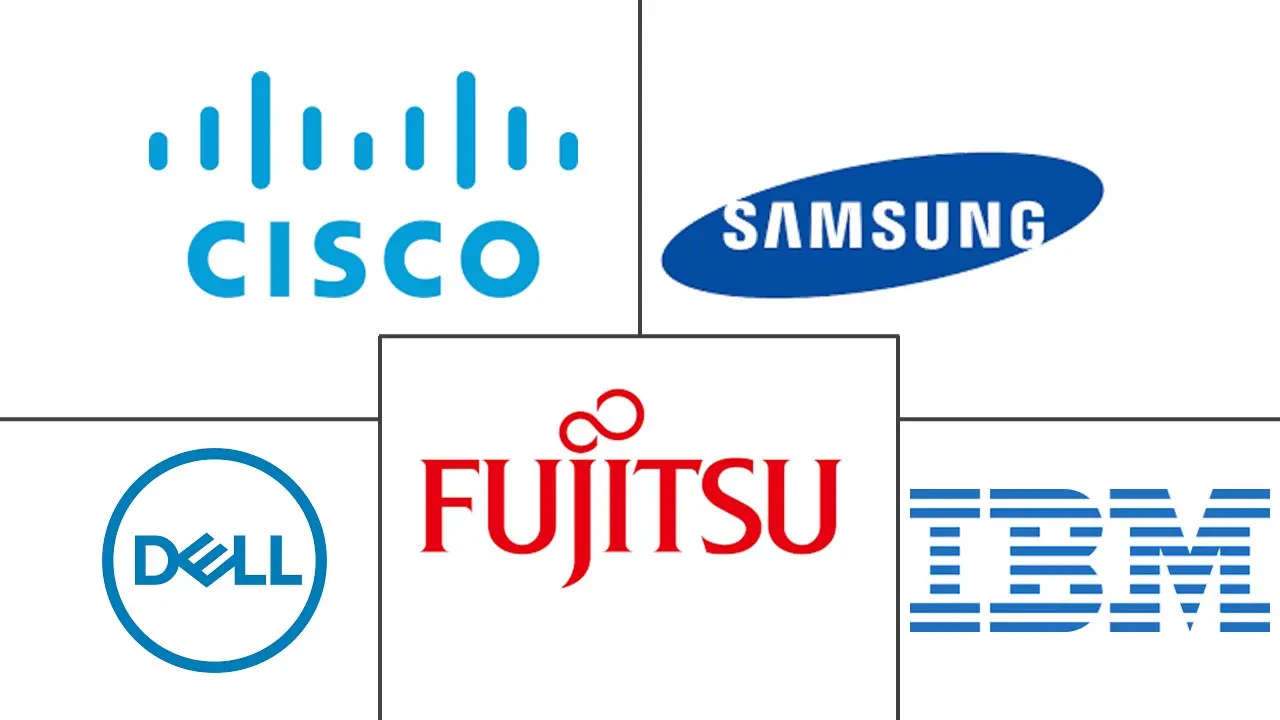Market Size of Europe ICT Industry

| Study Period | 2019 - 2029 |
| Base Year For Estimation | 2023 |
| Forecast Data Period | 2024 - 2029 |
| Historical Data Period | 2019 - 2022 |
| CAGR | 12.50 % |
| Market Concentration | Low |
Major Players
*Disclaimer: Major Players sorted in no particular order |
Europe ICT Market Analysis
Europe's ICT Market is expected to register a CAGR of 12.5% over the forecast period (2022 - 2027). Increasing demand for digitization and scalable IT infrastructure is anticipated to drive the market's growth in the European region.
- According to the European Commission's economic strategy, information and Communication Technologies (ICTs) are one of the key drivers for smart, sustainable, and inclusive growth. ICTs and the internet permeate the European economy, the increased use of broadband applications and services, and the spread of wireless devices, including smart devices and their applications. They are transforming the structures and dynamics of European society by enabling people to organize their lives and businesses in new ways, build global networks, manage information and learn, socialize, and contribute to the pool of online knowledge.
- The government is also initiating certain changes in the development of the European ICT sector. For instance, In April 2022, the European Commission released the 2022 Rolling Plan for ICT Standardisation. The Rolling Plan consists of four thematic areas supported by about 170 actions for ICT standardizations these types of intiatives drives the market growth.
- Additionally, European ICT is estimated to be one of the emerging markets in the future, which requires hardware, software, and other IT services. The increasing penetration of technology giants in the country to take advantage of the Privatization in Europe.
- People's spending on computers and screens has increased as the IT sector has developed. Increased technology usage to stay productive, communicate, enjoy, and study through larger displays drives the market growth. The rise of competitive gaming platforms like e-sports and the growing popularity of virtual gaming are driving demand and growth in the hardware devices such as computers, laptops, and tablets. It is challenging to overcome the market's high industrial competitiveness among enterprises to accept improved technology to provide users with more current displays at the lowest possible price.
- While the COVID-19 epidemic has influenced European digital transformation, businesses are realigning their IT strategy, reducing operational expenses, automating operations, and deploying new technologies to increase efficiency. Robotic process automation, big data, artificial intelligence, machine learning, blockchain, cloud computing, the internet of things, cybersecurity, and augmented/virtual reality are all assisting businesses in achieving these goals.
Europe ICT Industry Segmentation
The study is structured to track the spending on ICT solutions and services by different industry verticals across European Region. The spending is segmented broadly based on the category of spending such as Enterprise hardware, software, services, and communications. Under the Enterprise hardware, the spending on Server/Storage and Network and other peripherals are considered, Under the Enterprise Software the spending on application development
and deployment, financial applications, human capital management, office suites, system infrastructure software, and other applications are considered, IT Services referer to the spending on IT consulting, systems integration, technology outsourcing, and other IT services, Key Technology preferences of the end-user industry verticals, such as Cloud, Artificial Intelligence also form part of our study. The assessment of the impact of COVID-19 is included in the study.
Europe ICT Market is Segmented by Type (Enterprise Hardware, Enterprise Software, IT Services Communication Services), by End-user Vertical (BFSI, IT & Telecom, Government, Retail and E-Commerce, Manufacturing), and by Country.
| By Type | |
| Enterprise Hardware | |
| Enterprise Software | |
| IT Services | |
| Communication Services |
| By End-user Vertical | |
| BFSI | |
| IT & Telecom | |
| Government | |
| Retail and E-Commerce | |
| Manufacturing | |
| Other Industry Verticals(Energy and Utilities, Healthcare, Construction) |
| By Country | |
| United Kingdom | |
| Germany | |
| France | |
| Rest of Europe |
Europe ICT Market Size Summary
The European ICT market is poised for significant growth, driven by the increasing demand for digitization and scalable IT infrastructure. As a key component of the European Commission's economic strategy, ICTs are instrumental in fostering smart, sustainable, and inclusive growth across the region. The proliferation of broadband applications, wireless devices, and smart technologies is reshaping societal structures and business dynamics, enabling new ways of organization, communication, and information management. Government initiatives, such as the 2022 Rolling Plan for ICT Standardisation, are further propelling market expansion by establishing frameworks for ICT standardization. The market is also witnessing a surge in technology adoption, with businesses leveraging advanced technologies like AI, big data, and cloud computing to enhance efficiency and reduce operational costs.
The competitive landscape of the European ICT market is characterized by the presence of numerous global players, who are actively pursuing strategies to expand their market share through collaborations, acquisitions, and product launches. The rise of consumer IoT products and services, along with the growing popularity of digital services, is creating new commercial opportunities and enhancing consumer choice. The market's growth is also fueled by the increasing penetration of technology giants and the demand for hardware devices driven by trends such as e-sports and virtual gaming. Despite the challenges posed by high industrial competitiveness, the market continues to evolve, with significant investments in managed services and domestic outsourcing, offering businesses the opportunity to optimize their IT operations and focus on core activities.
Europe ICT Market Size - Table of Contents
-
1. MARKET INSIGHTS
-
1.1 Market Overview
-
1.2 Value Chain Analysis
-
1.3 Porter's Five Forces Analysis
-
1.3.1 Threat of New Entrants
-
1.3.2 Bargaining Power of Buyers
-
1.3.3 Bargaining Power of Suppliers
-
1.3.4 Threat of Substitutes
-
1.3.5 Intensity of Competitive Rivalry
-
-
1.4 Impact of Covid-19 on the Market
-
-
2. MARKET SEGMENTATION
-
2.1 By Type
-
2.1.1 Enterprise Hardware
-
2.1.2 Enterprise Software
-
2.1.3 IT Services
-
2.1.4 Communication Services
-
-
2.2 By End-user Vertical
-
2.2.1 BFSI
-
2.2.2 IT & Telecom
-
2.2.3 Government
-
2.2.4 Retail and E-Commerce
-
2.2.5 Manufacturing
-
2.2.6 Other Industry Verticals(Energy and Utilities, Healthcare, Construction)
-
-
2.3 By Country
-
2.3.1 United Kingdom
-
2.3.2 Germany
-
2.3.3 France
-
2.3.4 Rest of Europe
-
-
Europe ICT Market Size FAQs
What is the current Europe ICT Market size?
The Europe ICT Market is projected to register a CAGR of 12.5% during the forecast period (2024-2029)
Who are the key players in Europe ICT Market?
IBM Corporation, Cisco Systems, Inc., Samsung Electronics Co., Ltd, Dell Inc. and Fujitsu are the major companies operating in the Europe ICT Market.

